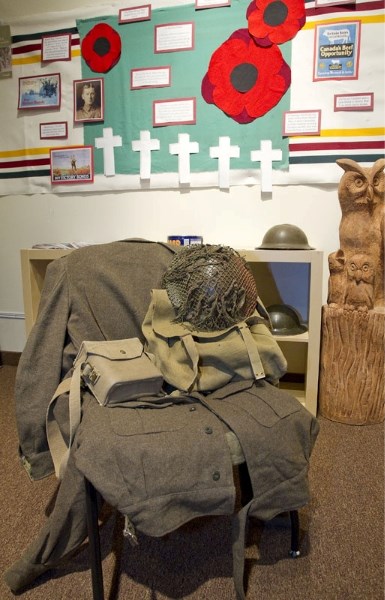Roy Toomey says most people probably think wearing a soldier’s uniform would be a neat experience, exhilarating even. That feeling lasts right up until you actually put it on.
“People often think, ‘These guys look really cool in their uniforms’,” the MusĂ©e HĂ©ritage Museum’s education programmer stated, before remarking, “Yeah, they do look great, but just think of the discomfort of wearing this uniform … the itchy wool and the heavy helmet.”
The museum is doing something special for Remembrance Day this year. For a while now, staffers at the centre in St. Albert Place have wanted to set up displays featuring some artifacts from their own archives. Now, that is finally coming to fruition thanks to the collaboration they have developed with the Loyal Edmonton Regiment and the Michif Cultural and Resource Institute.
“We do have pieces in our collection that we’ve been wanting to bring out and show, and we have some people who are passionate about Remembrance Day and about those who serve for us,” says program manager Shari Strachan.
She was clearly referring to Toomey.
“As soon as we said, ‘You know, we need to do something in the Discovery Room’. That’s really Roy’s passion. We’re all passionate about it. He really has a passion for that and an interest in that.”
As the leader in this endeavour, he revelled at the chance to talk about war and peace to the museum’s visitors.
It all stems from his family history. His grandfather was a soldier for almost three decades, serving in the Second World War before getting into peacekeeping in the Gaza Strip and Lebanon. Toomey was raised to understand and appreciate what people like his grandfather still fight for in the world.
“We owe all our freedoms – the things that we enjoy now – we owe so much of that to these men and women who gave their lives. I wish more Canadians took the time to remember and to bring their families to the cenotaph.”
“Remembrance Day is a very important time to remember those who have served our country, and also those who have paid that ultimate sacrifice. To me, these guys really are heroes. These are guys we should remember not just one day a year, but I say every day. To me, it’s one of the most important holidays that we have here in Canada.”
Strachan added that it’s important to start by educating the young.
“We work mostly with kids, at least during the school year, so it’s really important to teach the next generation about the past and how it pertains to us today.”
Apart from the usual activities for all ages of children (including handouts, colouring sheets and puzzles), there will be other – perhaps more involving – features. That World War II battle dress jacket is the first thing that comes to mind. There are some new displays that will feature photos of people from the city’s past who participated in conflicts ranging from the 1885 Rebellion, the Boer War and both world wars. A wonderful parchment muster roll (written in grand calligraphic script) shows the names of those people as well.
The unique exhibit is also a natural tie-in to the showing of photos by local photographer David Bowering, on now at the Art Gallery of St. Albert. Afghanistan Through My Lens will be open on Friday right after the public ceremony at the cenotaph, until 2 p.m. The Musée will open earlier, at 10 a.m. but close at the same time.
The MusĂ©e will also hold screenings of A Living History of Métis Families, previously premiered back in March. The film was directed and produced by St. Albert resident Dr. Judy Iseke as part of an Internet project called Our Elder Stories. It features Dorothy Chartrand, a Métis grandmother and descendant of one of the city’s founding families, as she tells stories about how Métis families were affected by the social and political changes from the 1800s to today.




